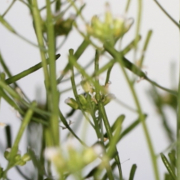PLoS Genet: Hybrid incom- patibility & R gene evolution
From collaboration with Alcázar, Koornneef and Parker labs:
Rubén Alcázar, Marcel von Reth, Jaqueline Bautor, Eunyoung Chae, Detlef Weigel, Maarten Koornneef, Jane E. Parker
PLoS Genetics
Published: December 11, 2014DOI: 10.1371/journal.pgen.1004848
Mechanisms underlying speciation in plants include detrimental (incompatible) genetic interactions between parental alleles that incur a fitness cost in hybrids. We reported on recessive hybrid incompatibility between an Arabidopsis thaliana strain from Poland, Landsberg erecta (Ler), and many Central Asian A. thaliana strains. The incompatible interaction is determined by a polymorphic cluster of Toll/interleukin-1 receptor-nucleotide binding-leucine rich repeat (TNL) RPP1 (Recognition of Peronospora parasitica1)-like genes in Ler and alleles of the receptor-like kinase Strubbelig Receptor Family 3 (SRF3) in Central Asian strains Kas-2 or Kond, causing temperature-dependent autoimmunity and loss of growth and reproductive fitness. Here, we genetically dissected the RPP1-like Ler locus to determine contributions of individual RPP1-like Ler (R1–R8) genes to the incompatibility. In a neutral background, expression of most RPP1-like Ler genes, except R3, has no effect on growth or pathogen resistance. Incompatibility involves increased R3 expression and engineered R3 overexpression in a neutral background induces dwarfism and sterility. However, no individual RPP1-like Ler gene is sufficient for incompatibility between Ler and Kas-2 or Kond, suggesting that co-action of at least two RPP1-like members underlies this epistatic interaction. We find that the RPP1-like Ler haplotype is frequent and occurs with other Ler RPP1-like alleles in a local population in Gorzów Wielkopolski (Poland). Only Gorzów individuals carrying the RPP1-like Ler haplotype are incompatible with Kas-2 and Kond, whereas other RPP1-like alleles in the population are compatible. Therefore, the RPP1-like Ler haplotype has been maintained in genetically different individuals at a single site, allowing exploration of forces shaping the evolution of RPP1-like genes at local and regional population scales.



